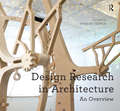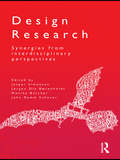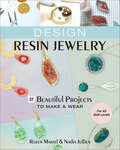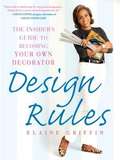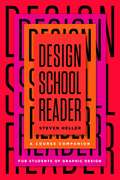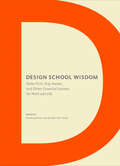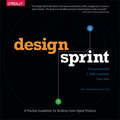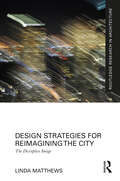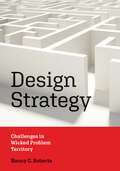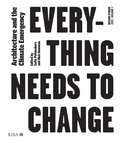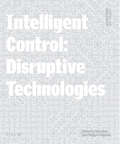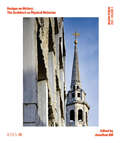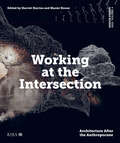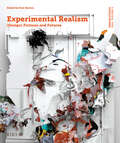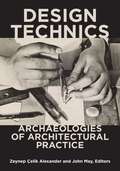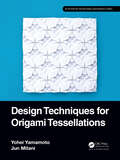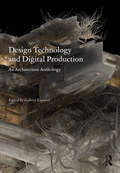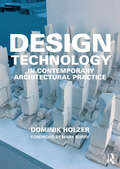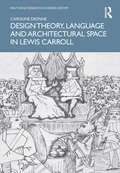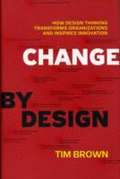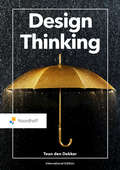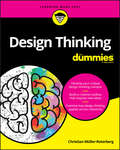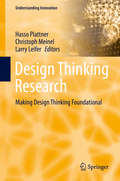- Table View
- List View
Design Research in Architecture: An Overview (Design Research in Architecture)
by Murray FraserWhat is the role of design research in the types of insight and knowledge that architects create? That is the central question raised by this book. It acts as the introductory overview for Ashgate’s major new series, ’Design Research in Architecture’ which has been created in order to establish a firm basis for this emerging field of investigation within architecture. While there have been numerous architects-scholars since the Renaissance who have relied upon the interplay of drawings, models, textual analysis, intellectual ideas and cultural insights to scrutinise the discipline, nonetheless, until recently, there has been a reluctance within architectural culture to acknowledge and accept the role of design research as part of the discourse. However, in many countries around the world, one of the key changes in architecture and architectural education over the last decade has been the acceptance of design as a legitimate research area in its own right and this new series provides a forum where the best proponents of architectural design research can publish their work. This volume provides a broad overview on design research that supports and amplifies the different volumes coming out in the book series. It brings together leading architects and academics to discuss the more general issues involved in design research. At the end, there is an Indicative Bibliography which alludes to a long history of architectural books which can be seen as being in the spirit of design research.
Design Research: Synergies from Interdisciplinary Perspectives
by Jesper SimonsenDesign Research is a new interdisciplinary research area with a social science orientation at its heart, and this book explores how scientific knowledge can be put into practice in ways that are at once ethical, creative, helpful, and extraordinary in their results. In order to clarify the common aspects – in terms of features and approaches – that characterize all strands of research disciplines addressing design, Design Research undertakes an in-depth exploration of the social processes involved in doing design, as well as analyses of the contexts for design use. The book further elicits ‘synergies from interdisciplinary perspectives’ by discussing and elaborating on differing academic perspectives, theoretical backgrounds, and design concept definitions, and evaluating their unique contribution to a general core of design research. This book is an exciting contribution to this little explored field, and offers a truly interdisciplinary approach to the treatment of design and the design process. It is valuable reading for students in disciplines such as design studies and theory, participatory design, informatics, arts based education, planning, sociology, and interdisciplinary programmes in humanities and technology.
Design Resin Jewelry: 37 Beautiful Projects to Make & Wear; For All Skill Levels
by Rozen Martel Nadia JullienCreate gorgeous handmade jewelry Hop on the hottest trend with handcrafted resin jewelry! Resin experts Rozen Martel-Gouélibo and Nadia Jullien share 37 different customizable projects to accessorize any outfit. Never crafted with resin? No worries! A full list of materials, supplies, and how-to instructions are provided for a beginner-friendly experience. Including, the must-know information such as the various types of resins and their uses, how to mold and cast resin, and how to turn your creations into gorgeous pieces of jewelry. Create necklaces, earrings, rings, bracelets, and more, build confidence with the techniques taught, and put your own creative spin on custom jewelry. 37 handcrafted jewelry projects for all skill levels Resin, the thick, glossy topcoat that brings that professional finish to art projects, is versatile and easy to learn and customize Make necklaces, earrings, rings, bracelets, and more with visual step-by-step instructions
Design Rules
by Elaine GriffinRecipient of the Gold Medal in the Living Now Awards-Home Improvement The essential do-it-yourself guide from one of the top designers in the country that uncovers the secret home design rules used by the pros Many design books are filled with lavish photography of perfect rooms that most of us can only dream of re-creating. Without any practical advice, the look is unattainable. That's where Design Rules comes in. Here, Elaine Griffin, one of the country's 100 top designers (House Beautiful), explains all the practical decorating standards that professionals use behind the scenes to create flowing, balanced, gorgeous design. Packed with helpful illustrations and hundreds of step-by-step tips, Design Rules includes essential advice such as: ?Pick a pleasing color palette (that really works) ?Correctly size their bedsize tables (so they don't tower over their beds) ?Enhance the visual appeal of windowless rooms (so they're not dungeons) ?Design furniture arrangements that function and flow ?Style up even the most forlorn kitchens, baths and yes, basements and laundry rooms (honey, no space is too dreadful to be made ultra fab) ?Brighten up their kitchens with a can of paint and a burst of strategically- placed color (location, location, location!) ?Figure out which styles of furniture go together (there is a rule and it's easy!) ?Make their own personalities shine throughout their homes (because they should) ?And oodles more! Design Rules is for the growing number of savvy, novice home designers who are well-versed in what good design looks like, but need advice on how to translate it into their own home. It is the home design bible people have been waiting for.
Design School Reader: A Course Companion for Students of Graphic Design
by Steven HellerAn Essential Collection of Essays and Musings on Graphic Design from One of the Field's Leading Educators In this wide-ranging compilation, art director, writer, and lecturer Steven Heller shares his passion for graphic design with readers, whom he invites to consider that design can be discerned in all things natural and manmade. Developed as content for a class devoted to reading, this collection is not overtly about conventional design, but about a variety of topics viewed through the lens of design. Offered as a primer for undergraduate and graduate students, Design School Reader presents more than forty essays on subjects such as: The role of design in politicsVisual culture and the social impact of designKey moments in the history of typographyTechnological innovationsThe power of branding and logosEthical considerations and dilemmasImportant figures in the design world Divided into five parts—Design Language; Design Dialects; Politics, Ideology, Design; Business and Commerce; and Inspiration and Discoveries—each section features a collection of essays culled from Heller&’s extensive publications from the past several decades. At the end of every essay, readers will find discussion points to prompt further lines of inquiry. As Heller notes, &“The key is to read, discuss, and debate.&” Students, aficionados, and anyone with a healthy curiosity will thoroughly enjoy this illuminating and thought-provoking assemblage of perspectives on the practice.
Design School Wisdom: Make First, Stay Awake, and Other Essential Lessons for Work and Life
by Brooke Johnson and Jennifer Tolo PierceLearn to see the world with the smarts and visual acumen of a great designer. This treasure trove of pithy aphorisms, longer-form essays, and first-person interviews compiles years of design school education into one comprehensive yet compact book. Here are lessons in life and work, learned both in the classroom and on the job, from design teachers, students, and gurus, covering everything from practical know-how to big-picture brilliance. Design School Wisdom provides a well of inspiration for aspiring designers, visual thinkers, students, grads, and professional creatives looking to reinvigorate their practice.
Design Sprint: A Practical Guidebook for Building Great Digital Products
by Richard Banfield C. Todd Lombardo Trace WaxWith more than 500 new apps entering the market every day, what does it take to build a successful digital product? You can greatly reduce your risk of failure with design sprints, a process that enables your team to prototype and test a digital product idea within a week. This practical guide shows you exactly what a design sprint involves and how you can incorporate the process into your organization.Design sprints not only let you test digital product ideas before you pour too many resources into a project, they also help everyone get on board—whether they’re team members, decision makers, or potential users. You’ll know within days whether a particular product idea is worth pursuing.Design sprints enable you to:Clarify the problem at hand, and identify the needs of potential usersExplore solutions through brainstorming and sketching exercisesDistill your ideas into one or two solutions that you can testPrototype your solution and bring it to lifeTest the prototype with people who would use it
Design Strategies for Reimagining the City: The Disruptive Image (Routledge Research in Architecture)
by Linda MatthewsDesign Strategies for Reimagining the City is situated between projective geometry, optical science and architectural design. It draws together seemingly unrelated fields in a series of new digital design tools and techniques underpinned by tested prototypes. The book reveals how the relationship between architectural design and the ubiquitous urban camera can be used to question established structures of control and ownership inherent within the visual model of the Western canon. Using key moments from the broad trajectory of historical and contemporary representational mechanisms and techniques, it describes the image’s impact on city form from the inception of linear perspective geometry to the digital turn. The discussion draws upon combined fields of digital geometry, the pictorial adaptation of human optical cues of colour brightness and shape, and modern image-capture technology (webcams, mobile phones and UAVs) to demonstrate how the permeation of contemporary urban space by digital networks calls for new architectural design tools and techniques. A series of speculative drawings and architectural interventions that apply the new design tools and techniques complete the book. Aimed at researchers, academics and upper-level students in digital design and theory, it makes a timely contribution to the ongoing and broadly debated relationship between representation and architecture.
Design Strategies in Architecture: An Approach to the Analysis of Form
by Geoffrey H. BakerModern architecture has become extremely complex and its study has been made more difficult by changes in fashion and a proliferation of design modes. In this book, Geoffrey Baker develops a methodology for design analysis that reveals the underlying organisation of buildings.Part One explains the nature and role of architecture in a wide-ranging discussion extending from geometry to symbolism. Part Two demonstrates the analytical methodology by reference to cities and works by modern masters such as Aalto, Meier and Stirling. In this second revised edition, Dr Baker has added a chapter outlining the relationship between some current perceptions of science, art and philosophy, and how these impinge on architecture. The discussion compares Futurism, Constructivism, Suprematism, High Tech, Deconstruction and the attitude of the avant-garde, with the phenomenology of Bachelard and Heiddeger.
Design Strategy: Challenges in Wicked Problem Territory (Design Thinking, Design Theory)
by Nancy C. RobertsA new approach to addressing the contemporary world&’s most difficult challenges, such as climate change and poverty.Conflicts over &“the problem&” and &“the solution&” plague the modern world and land problem solvers in what has been called &“wicked problem territory&”—a social space with high levels of conflict over problems and solutions. In Design Strategy, Nancy C. Roberts proposes design as a strategy of problem solving to close the gap between an existing state and a desired state. Utilizing this approach, designers and change agents are better able to minimize self-defeating conflicts over problems and solutions, break the logjam of opposition, and avoid the traps that lock problem solvers into a never-ending cycle of conflict.Design as a field continues to grow and evolve, but Design Strategy focuses on three levels of design where &“wicked problems&” tend to lurk—strategic design (of private and public organizations), systemic design (of networked and overlapping economic, technical, political, and social subsystems), and regenerative design (of life-giving realignment between humanity and nature). Within this framework, Roberts presents refreshingly interdisciplinary case studies that integrate theory and practice across diverse fields to guide professionals in any domain—from business and nonprofit organizations to educational and healthcare systems—and finally offers hope that humanity can tackle the existential challenges we face in the twenty-first century.
Design Studio Vol. 1: Architecture and the Climate Emergency
by Sofie Pelsmakers; Nick NewmanWant to keep up with emerging design thinking and issues worldwide? Design Studio is a new thematic series that distils the most topical work and ideas from schools and practices globally. The first volume launches with a statement: Everything Needs to Change. Exploring architecture and the climate emergency, editors Sofie Pelsmakers (author of Environmental Design Sourcebook) and Nick Newman (climate activist and Director at Studio Bark), are channelling the message of Greta Thunberg to inspire, enthuse and inform the next generation of architects. Featuring articles, building profiles and case studies from a range of leading voices, it explores solutions to climatic, environmental and social challenges. It urges readers to radically rethink what it means to be an architect in an era of climate crisis, and what the role of the architect is or can be. Discover how using local materials, working with nature, radical design processes, transformative learning and activism can help us find hope in the burning world. Together, we can force change for a more sustainable and equitable tomorrow. This first volume is produced in four unique fluorescent colours – green, red, yellow and purple – to be your own poster for change.
Design Studio Vol. 2: Disruptive Technologies
by Rob Hyde Filippos FilippidisHow should we train? What should we learn? What is our value? Disruptive technologies have increased speculation about what it means to be an architect. Innovations simultaneously offer great promise and potential risk to design practice. This volume identifies the game-changing trends driven by technology, and the opportunities they provide for architecture, urbanism and design. It advocates for an approach of intelligent control that transforms practice with specialist knowledge of technological models and systems. It features new developments in automation, generative design, augmented reality, videogame urbanism, artificial intelligence and robotics, as well as lived experiences within a continually shifting landscape. Showcasing evolving research, it discusses the cultural, social, environmental and political implications of various technological trajectories. In doing so it speculates upon future urban, spatial, aesthetic and formal possibilities within architecture. The future is already here. Now is the time to act. Features: Austrian Institute of Technology AiT - City Intelligence Lab CiT, Bryden Wood, Mollie Claypool, Soomeen Hahm, Hawkins\Brown, LASSA Architects, The Living, Danil Nagy, Odico Construction Robotics, Stefana Parascho, Luke Caspar Pearson, SHoP Architects, Kostas Terzidis, Mette Ramsgaard Thomsen and Sandra Youkhana.
Design Studio Vol. 3: The Architect as Physical Historian
by Jonathan HillEach architectural design is a new history. To identify what is novel or innovative, we need to consider the present, past and future. We expect historical narratives to be written in words, but they can also be delineated in drawing, cast in concrete or seeded in soil. The aim of this volume is to understand each design as a visible and physical history. Historical understanding is investigated as a stimulus to the creative process, highlighting how architects learn from each other and other disciplines. This encourages us to consider the stories about history that architects fabricate. An eminent set of international contributors reflect on the relevance of historical insight for contemporary design, drawing on the rich visual output of innovative studios worldwide in practice and education. Wide ranging and thought-provoking articles encompass fact, fiction, memory, time, etymology, civilisation, racial segregation and more. Features: Elizabeth Dow, Pezo von Ellrichshausen, Terunobu Fujimori, Perry Kulper, Lesley Lokko, Yeoryia Manolopoulou, Niall McLaughlin, Aisling O’Carroll, Arinjoy Sen, Amin Taha and Sumayya Vally.
Design Studio Vol. 4: Architecture After the Anthropocene
by Harriet Harriss Naomi HouseWithout environmental justice, there can be no social justice. This volume sets the table for inclusive architectural engagement during a time circumscribed by pandemic, climate change and inequality. An esteemed group of international voices amplify interactions involving sexism, racism, classism, homophobia, transphobia and environmental catastrophe, exploring how they inextricably linked. Without acknowledging the interconnectedness of these injustices, we will not find effective ways to halt the deepening crisis. Features: Marcos Cruz, Casper Laing Ebbensgaard, Antón García-Abril, Alexandra Daisy Ginsburg, Ariane Lourie Harrison, Kerry Holden, Walter Hood, Joyce Hwang, Kabage Karanja, V. Mitch McEwen, Débora Mesa, Timothy Morton, Stella Mutegi, Brenda Parker, Carolyn Steel, McKenzie Wark, Kathryn Yusoff and Joanna Zylinska.
Design Studio Vol. 5: (Design) Fictions and Futures
by Gem BartonThe experimental realism provides architects with a vital means to test ideas and the untried. By injecting the experimental with a new realism, however, speculative design has the potential to advance new inclusive, equitable and desirable futures. Showcasing cutting-edge insight, the book advocates for the inclusion of speculative spatial design in architectural development. It explores the real-word application of nearfuture fantastical storytelling and the power of imagination. Discover plural design reactions in response to real possible situations.
Design Technics: Archaeologies of Architectural Practice
by John May Zeynep Çelik AlexanderLeading scholars historicize and theorize technology&’s role in architectural design Although the question of technics pervades the contemporary discipline of architecture, there are few critical analyses on the topic. Design Technics fills this gap, arguing that the technical dimension of design has often been flattened into the broader celebratory rhetoric of innovation. Bringing together leading scholars in architectural and design history, the volume&’s contributors situate these tools on a broader epistemological and chronological canvas. The essays here construct histories—some panoramic and others unfolding around a specific episode—of seven techniques regularly used by the designer in the architectural studio today: rendering, modeling, scanning, equipping, specifying, positioning, and repeating.Starting with observations about the epistemological changes that have unfolded in the discipline in recent decades but seeking to offer a more expansive meaning for technics, the volume casts new light on concepts such as form, experience, and image that have played central roles in historical architectural discourses. Among the questions addressed: How was the concept of form immanent in practices of scanning since the late nineteenth century? What was the historical relationship between rendering and experience in Enlightenment discourses? How did practices of specifying reconfigure the distinction between intellectual and manual labor? What kind of rationality is inherent in the designer&’s constant clicking of the mouse in front of her screen? In addressing these and other questions, this engaging and timely collection thereby proposes technics as a site for historical and philosophical reflection not only for those engaged in architectural design but also for any scholar working in the humanities today.Contributors: Lucia Allais, Edward Eigen, Orit Halpern, John Harwood, Matthew C. Hunter, and Michael Osman.
Design Techniques for Origami Tessellations (AK Peters/CRC Recreational Mathematics Series)
by Jun Mitani Yohei YamamotoDesign Techniques for Origami Tessellations is both a collection of origami tessellations and a manual to design them. This book begins by explaining general design methods, the history and definitions of origami tessellations, and the geometric features of flat origami, before moving on to introduce a brand-new design method: the "twist-based design method." This method generates base parts that connect "twist patterns” (that can be folded with a twist) without using a lattice. Therefore, it can generate base parts such as regular pentagons, which cannot be generated with more conventional methods, and can generate new origami tessellations connected to them. Features: No proofs or formulas in the text and minimal jargon. Suitable for readers with a roughly middle school to high school level of mathematical background. Web application implementing the method described in this book is available, allowing the readers to design their own patterns.
Design Technology and Digital Production: An Architecture Anthology
by Gabriel EsquivelThis book is a rigorous account of architecture’s theoretical and technological concerns over the last decade. The anthology presents projects and essays produced at the end of the first digital turn and the start of the second digital turn. This anthology engages and deploys a variety of discourses, topics, criteria, pedagogies, and technologies, including some of today’s most influential architects, practitioners, academics, and critics. It is an unflinchingly rigorous and unapologetic account of architecture’s disciplinary concerns in the last decade. This is a story that has not been told; in recent years everything has been refracted through the prism of the post-digital generation.Design Technology and Digital Production illustrates the shift to an architectural world where we can learn with and from each other, develop a community of new technologies and embrace a design ecology that is inclusive, open, and visionary. This collection fosters a sense of shared experience and common purpose, along with a collective responsibility for the well-being of the discipline of architecture as a whole.
Design Technology in Contemporary Architectural Practice
by Dominik HolzerDesign Technology in Contemporary Architectural Practice lifts the curtain to unveil how eleven world-leading design studios integrate technology (such as computational design, BIM, and digital fabrication) as part of their day-to-day design exploration and delivery. Via first-hand accounts, the book offers rare insights about how these firms apply technology to purposefully disrupt and support their creative design processes in order to then explore how technology can be integrated on an organisational level. The resulting practice stories are loosely tied to four chapters that discuss how Design Technology corresponds to studio culture, collaboration and delivery protocols, business opportunities, knowledge sharing, staff empowerment, and more. The author is less interested in presenting the latest and greatest tools than in focusing on cultural and organisational challenges and opportunities. This book benefits both the professional market (such as design firms reflecting on their technology use), as well as the academic context (with its critical reflection on the interface between design process and technology support). Stories from the following design firms are included: Coop Himmelb(l)au Foster + Partners Bjarke Ingels Group (BIG) Zaha Hadid Architects Diller Scofidio + Renfo Heatherwick Studio Morphosis Architects SO-IL Woods Bagot Herzog & de Meuron LASSA
Design Theory, Language and Architectural Space in Lewis Carroll (Routledge Research in Design History)
by Caroline DionneThis volume offers spatial theories of the emergent based on a careful close reading of the complete works of nineteenth-century writer and mathematician Lewis Carroll—from his nonsense fiction, to his work on logic and geometry, including his two short pamphlets on architecture. Drawing on selected key moments in our philosophical tradition, including phenomenology and sociospatial theories, Caroline Dionne interrogates the relationship between words and spaces, highlighting the crucial role of language in processes of placemaking. Through an interdisciplinary method that relates literary and language theories to theories of space and placemaking, with emphasis on the social and political experience of architectural spaces, Dionne investigates Carroll’s most famous children’s books, Alice’s Adventures in Wonderland and Through the Looking-Glass and What Alice Found There, in relation to his lesser-known publications on geometry and architecture. The book will be of interest to scholars working in design theory, design history, architecture, and literary theory and criticism.
Design Theory, Language and Architectural Space in Lewis Carroll (Routledge Research in Design History)
by Caroline DionneThis volume offers spatial theories of the emergent based on a careful close reading of the complete works of nineteenth-century writer and mathematician Lewis Carroll—from his nonsense fiction, to his work on logic and geometry, including his two short pamphlets on architecture. Drawing on selected key moments in our philosophical tradition, including phenomenology and sociospatial theories, Caroline Dionne interrogates the relationship between words and spaces, highlighting the crucial role of language in processes of placemaking. Through an interdisciplinary method that relates literary and language theories to theories of space and placemaking, with emphasis on the social and political experience of architectural spaces, Dionne investigates Carroll’s most famous children’s books, Alice’s Adventures in Wonderland and Through the Looking-Glass and What Alice Found There, in relation to his lesser-known publications on geometry and architecture. The book will be of interest to scholars working in design theory, design history, architecture, and literary theory and criticism.
Design Thinking (Routledge-Noordhoff International Editions)
by Teun den DekkerThis book is not just for reading. Design Thinking is something you need to actually do. Reading about design thinking will increase your knowledge, but by doing it, you will learn what design thinking can mean for you, in your studies and your work. In this book we encourage you to take action: design thinking by doing. Since the end of the last millennium, design thinking has received an increasing amount of attention from the business community, social organizations, universities and colleges.Organizations are confronted with complex problems and issues that are no longer self-containe, clear or easy to define. The creative solution strategy offered by design thinking appears to be increasingly needed to adequately respond to the questions, wishes and needs of customers and society as a whole. This book unravels the thinking and working process of design thinking and offers practical tools for getting started. The author approaches design thinking in four chapters, from different perspectives: as a way of thinking, a way of working, a project approach and a tool box.Design thinking is a way of thinking answers the questions: How do design thinkers approach problems and challenges? Which six fundamental attitudes do they use and what do you need to know in order to use them? Design thinking is a way of working answers questions such as: What phases and milestones does the design process distinguish? What is the difference between the more structured design process and the ‘messy’ cycle of design thinking? Because you learn design thinking by doing, you will practice this in Design thinking is a project approach.Finally, in the last chapter Design thinking is a tool box, the methods and tools that you use in a design project will be discussed. This international edition of Design Thinking is written for students and workers who want to apply design thinking to tackle challenges, problems or complex (social) issues in a different, practical way within their own professional practice.
Design Thinking For Dummies
by Muller-RoterbergDevelop your unique design thinking mindset Build a creative toolbox that inspires new ideas Examine how design thinking applies across industries Challenge your creativity methods Design thinking is not just the property of graphic designers. This approach to creating solutions by thinking from the customer perspective can lead to new and innovative ideas that old methods could not approach.??Design Thinking For Dummies??provides a jump-start to get you and your organization on the path to new creativity. Written by a design thinking thought leader, this book helps you through the design thinking cycle and shows how it can help any industry. Inside... Building creative environments Facilitating design thinking workshops Implementing your solutions Applying design thinking to business Tips for transforming your organization
Design Thinking Research
by Christoph Meinel Hasso Plattner Larry LeiferThis book summarizes the results of the second year in the Design Thinking Research Program, a joint venture of Stanford University in Palo Alto and Hasso Plattner Institute in Potsdam. The authors have taken a closer look at the issue of co-creation from different points-of-view. The concept of co-creation can also be applied to the phase in which new ideas and related thought start to influence companies, the economy, our culture, and society. The perpetual pursuit for inventions, new creations and innovations is inherent in human nature. The concept behind co-creation may sound simple, however, it is both an essential element of Design Thinking and highly complex. It is about creating positive synergies for all parties involved.
